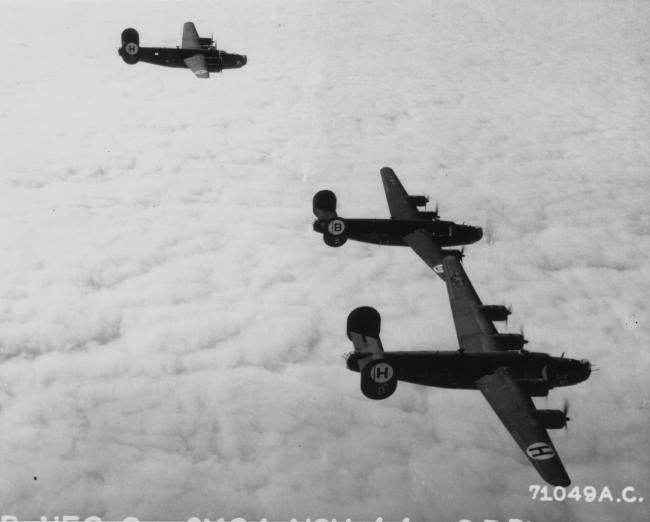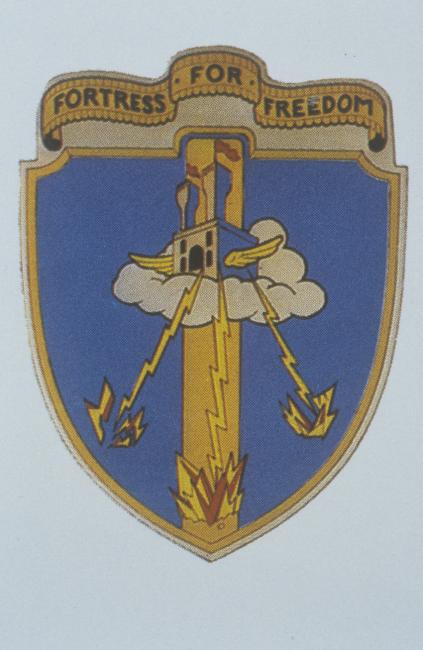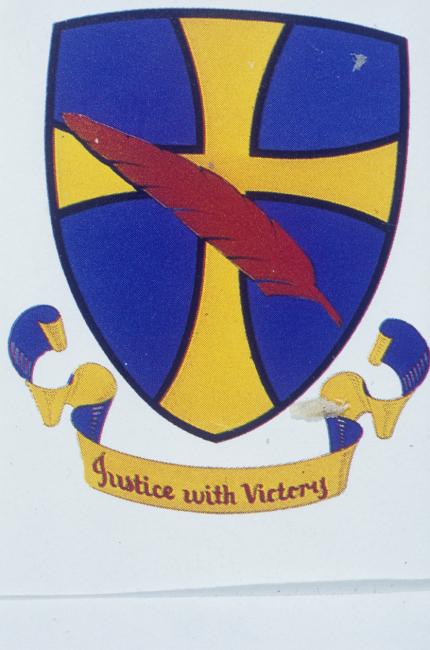428
21 June 1944
Added caption
Object Number - UPL 16460 - B-17 42-102622 Borrowed Time
Official Description
The Eighth begins shuttle bombing missions (FRANTIC) between UK and bases in USSR. P-47’s (2 groups) escort the Heavy Bombers from just off German coast to Stendal where a P-51 group continues escort to, and suppprt over, the target (synthetic oil plant at Ruhland). 123 B-17’s bomb primary target, 21 bomb Elsterwerda, and a lone B-17 bombs Riesa due to a bomb rack malfunction. After the attack, the supporting P-51 group is relieved 50 miles south east of Poznan by 65 other P-51’s which are to accompany the Heavy Bombers to USSR. 50 miles south east of Brest Litovsk 20 to 30 fighters attack the force. In the resulting battle 1 US and 6 German fightersare destroyed. A single B-17 is lost (to unknown causes) on the flight. 144 Heavy Bombers land in USSR, 73 at Poltava, and the rest at Mirgorod. The 64 remaining P-51’s land at Piryatin. The shuttle run is made in conjunction with a large-scale effort against targets in Berlin area.
935 Heavy Bombers attack city areas, motor industries, and targets of opportunity in and near Berlin, Genshagen, Basdorf, Rangsdorf, Trebbin, Belzig, Potsdam, Stendal, and surrounding areas. 19 Heavy Bombers are lost. Fighters fly 902 sorties in supprt of this mission, claiming 18 fighters destroyed, with a loss of 6.
During 21/22 June the 73 B-17’s which earlier landed at Poltava are attacked for 2 hours by an estimated 75 German bombers led by airplanes dropping flares. 47 Heavy Bombers are destroyed and most of the remainder severely damaged. Heavy damage is also suffered by stores of fuel and ammo.
Description
Ruhland, Germany - The target, south of Berlin, bombed by 114 fortresses with an escort of 70 Mustangs went off as planned but not before the Germans destroyed 43 B-17's and damaged 26. Landed in Russia.
Mission Details
Description: BOMB TARGETS OF OPPORTUNITY
Mission Statistics
- Tonnage Dropped: 10 T
Description: BOMB TARGETS OF OPPORTUNITY
Mission Statistics
- Tonnage Dropped: 17 T
Description: BOMB TARGETS OF OPPORTUNITY
Mission Statistics
- Tonnage Dropped: 30 T
Description: INDUSTRIAL COMPLEX

- Unit Hierarchy: Group
- Air Force: Eighth Air Force
- Type Category: Bombardment
Mission Statistics
- Tonnage Dropped: 181 T
Description: INDUSTRIAL COMPLEX
Mission Statistics
- Tonnage Dropped: 3 T
BERLIN (Primary)
Description: INDUSTRIAL COMPLEX
Aircraft Type: B-17 Flying Fortress
Notes: 1st Bomb Division was made up of 91st Bomb Group, 92nd Bomb Group, 303rd Bomb Group, 305th Bomb Group, 306th Bomb Group,351st Bomb Group, 379th Bomb Group, 381st Bomb Group, 384th Bomb Group, 389th Bomb Group, 401st Bomb Group, 457th Bomb Group. 457th BG - MISSION NO. 73 - BERLIN, GERMANY 21 JUNE, 1944 The plans called for the greatest aerial assault in history. Although the effort was reduced by more than half before take off, the operation as carried out remained the largest to date. One thousand bombers from Italy were scheduled to fly north, while 900 RAF Lancaster bombers were to follow the Eighth Air Force to the center of Berlin for their first daylight raid into Germany. These two operations were scrubbed and only the Eighth attacked. In the first deep penetration of Germany since D Day, the 457th dispatched 42 planes for the mission, composing the entire 94th B Combat Wing except for twelve craft in the high box. In addition one squadron was supplied for a composite box. Major Leroy Watson was Air Commander of the lead B box, with Captain Russell M. Selwyn as pilot. Capt. Richard E. Hoelzer was Commander of the low B box, with Lt. Vinton H. Mays as pilot. Major Fred A. Spencer was Commander of the high composite box, with Lt. Harry Stafford as pilot. Three ships aborted from the lead box reducing its strength to fifteen craft. Bombing was by PFF and results were described as fair. At least six distinct bomb patterns were made over a very large area of Berlin. The aircraft piloted by Lt. Robert M. Krumm, a veteran of twenty-nine missions, developed engine trouble en route to the target, began lagging behind the formation, jettisoned its bombs and landed in Sweden. Upon leaving the target, the plane piloted by Lt. Hershel Wilson received a direct hit from flak, which knocked out one engine. It caught fire and the ship exploded. Only four of the crew survived. The craft piloted by Lt. Edward J. Reppa, flying his last mission, was hit just after bombs away by flak, which knocked out engines Number 2 and 3. He left the formation and started back to England alone. Over the North Sea all expendable equipment was thrown out to lighten the weight. Flying barely fast enough to maintain flying speed, he was able to land the craft, using all the runway before coming to a coasting stop at the end of the runway. Twenty-four of the returning planes sustained damage. For the day the Eighth Air Force dispatched 1177 aircraft to Berlin and the Berlin area. In addition, 163 B-17s were dispatched to the Ruhland synthetic oil refinery, southeast of Berlin, and then continued on to Russia. The following crews were lost on this date: Lt Hershel Wilson Lt Robert M. Krumm

- Unit Hierarchy: Division
- Air Force: Eighth Air Force
- Type Category: Bombardment

- Unit Hierarchy: Group
- Air Force: Eighth Air Force
- Type Category: Bombardment

- Unit Hierarchy: Group
- Air Force: Eighth Air Force
- Type Category: Bombardment

- Unit Hierarchy: Group
- Air Force: Eighth Air Force
- Type Category: Bombardment

- Unit Hierarchy: Group
- Air Force: Eighth Air Force
- Type Category: Bombardment
Mission Statistics
- Tonnage Dropped: 1081 T
BERLIN (Primary)
Description: INDUSTRIAL COMPLEX
Notes: 3rd Bomb Division was made up of B-17s is 94th Bomb Group, 385th Bomb Group, 390th Bomb Group, 447th Bomb Group, 452nd Bomb Group, 486th Bomb Group, 487th Bomb Group
![Three B-17 Flying Fortresses of the 94th Bomb Group are attacked by a Nazi Fighter aircraft during a mission. Printed caption on reverse of print: 'A-62641 USAF: Nazi fighter plane attacking Boeing B-17 "Flying Fortresses" during a bomb run over enemy installations somewhere in Europe, 10 September 1944. 100th[sic] Bomb Group, 3rd Bomb Division. U.S. Air Force Photo.'](https://assets.americanairmuseum.com/s3fs-public/styles/max_650x650/public/freeman/media-408505.jpg?itok=Hi-SN9sg)
- Unit Hierarchy: Division
- Air Force: Eighth Air Force
- Type Category: Combat organisation
Mission Statistics
- Tonnage Dropped: 254 T
BERLIN (Secondary)
Description: INDUSTRIAL COMPLEX
Mission Statistics
- Tonnage Dropped: 115 T
Description: INDUSTRIAL COMPLEX
Description: INDUSTRIAL COMPLEX
Mission Statistics
- Tonnage Dropped: 56 T
Description: INDUSTRIAL COMPLEX
Notes: 2nd Bomb Division was made up of 44th Bomb Group, 93rd Bomb Group, 389th Bomb Group, 392nd Bomb Group, 445th Bomb Group, 446th Bomb Group, 448th Bomb Group, 453rd Bomb Group, 458th Bomb Group, 466th Bomb Group, 467th Bomb Group, 491st Bomb Group, 492nd Bomb Group

- Unit Hierarchy: Division
- Air Force: Eighth Air Force
- Type Category: Combat organisation
Mission Statistics
- Tonnage Dropped: 171 T
Description: INDUSTRIAL COMPLEX
Mission Statistics
- Tonnage Dropped: 118 T
Description: INDUSTRIAL COMPLEX
Mission Statistics
- Tonnage Dropped: 71 T
POLTAVA
Description: ENEMY GROUND ATTACK
Notes: During the night of 21/22 June 1944 the 73 B-17s that earlier landed at Poltava were attacked on the ground for 2 hours by an estimated 75 German bombers led by aircraft dropping flares. 47 B-17s are destroyed and most of the remainder severely damaged. Heavy damage is also suffered to stores of fuel and ammunition. These were Operation FRANTIC aircraft shuttled to Russia in conjunction with a large-scale effort against targets in the Berlin area. See next entry.
Mission Statistics
- Tonnage Dropped: NA
POTSDAM (Opportunistic)
Description: INDUSTRIAL COMPLEX
Mission Statistics
- Tonnage Dropped: 103 T
RANGSDORF (Opportunistic)
Description: INDUSTRIAL COMPLEX
Mission Statistics
- Tonnage Dropped: 40 T
RIESA (Opportunistic)
Description: INDUSTRIAL COMPLEX
Description: OIL REFINERY
Notes: 145 of 163 B-17s begin shuttle bombing missions. (Operation FRANTIC - shuttle bombing mission between bases in the UK and Russia). Bombers attack the oil refinery at Ruhland, Germany. 144 B-17s land in the USSR, 73 at Poltava and the rest at Mirgorod.
![Three airmen of the 100th Bomb Group, Lieutenant Kenneth Menzie, Lieutenant Donald Strout and Lieutenant Norman Scott, plan the route they will take during the next mission in their B-17 Flying Fortress (serial number 42-30380). Image stamped on reverse: 'Reviewed and passed U.S. Army 23 Aug 1943 Press Censor E.T.O. U.S.A.' [stamp]'. Passed for publication 23 August 1943 INTLD 16 General Section Press Censorship Bureau '[stamp], 'Associated Press' [stamp] and '280035.' [Censor no.] Printed caption on reve](https://assets.americanairmuseum.com/s3fs-public/styles/max_650x650/public/freeman/media-378743.jpg?itok=oPPVVi6c)
- Unit Hierarchy: Group
- Air Force: Eighth Air Force
- Type Category: Bombardment

- Unit Hierarchy: Group
- Air Force: Eighth Air Force
- Type Category: Bombardment

- Unit Hierarchy: Group
- Air Force: Eighth Air Force
- Type Category: Bombardment

- Unit Hierarchy: Group
- Air Force: Eighth Air Force
- Type Category: Bombardment

- Unit Hierarchy: Group
- Air Force: Eighth Air Force
- Type Category: Bombardment
Description: INDUSTRIAL COMPLEX
Mission Statistics
- Tonnage Dropped: 20 T
STENDAL (Opportunistic)
Description: INDUSTRIAL COMPLEX
Mission Statistics
- Tonnage Dropped: 20 T
TREBBIN (Opportunistic)
Description: INDUSTRIAL COMPLEX
Mission Statistics
- Tonnage Dropped: 25 T
Connections
See how this entry relates to other items in the archive by exploring the connections below.
People

- Military/Civilian/Mascot: Military
- Nationality: American
- Unit: 334th Fighter Squadron
- Service Numbers: 35133124
- Highest Rank: Staff Sergeant
- Role/Job: Crew Chief

- Military/Civilian/Mascot: Military
- Nationality: American
- Unit: 401st Bomb Group 615th Bomb Squadron
- Highest Rank: Technical Sergeant
- Role/Job: Radio Operator
- Military/Civilian/Mascot: Military
- Nationality: American
- Unit: 384th Bomb Group 545th Bomb Squadron
- Service Numbers: 33574325
- Highest Rank: Staff Sergeant
- Role/Job: Top Turret Gunner / Flight Engineer
- Military/Civilian/Mascot: Military
- Nationality: American
- Unit: 384th Bomb Group 545th Bomb Squadron
- Service Numbers: O-758675
- Highest Rank: Second Lieutenant
- Role/Job: Pilot
- Military/Civilian/Mascot: Military
- Nationality: American
- Unit: 401st Bomb Group 612th Bomb Squadron
- Highest Rank: Second Lieutenant
- Role/Job: Bombardier / Navigator
Aircraft

- Aircraft Type: B-24 Liberator
- Nicknames: Archibald
- Unit: 453rd Bomb Group 735th Bomb Squadron

- Aircraft Type: B-24 Liberator
- Nicknames: Rough Riders
- Unit: 458th Bomb Group 755th Bomb Squadron
- Aircraft Type: B-24 Liberator
- Unit: 458th Bomb Group 492nd Bomb Group 755th Bomb Squadron 856th Bomb Squadron 857th Bomb Squadron 858th Bomb Squadron

- Aircraft Type: B-17 Flying Fortress
- Nicknames: Diana Queen Of The Chase
- Unit: 401st Bomb Group 612th Bomb Squadron

- Aircraft Type: B-17 Flying Fortress
- Nicknames: Spam-O-Liner
- Unit: 545th Bomb Squadron 384th Bomb Group
Revisions
Mission details added courtesy of Diane Elizabeth Reese from 457th Bomb Group Mission Documents. http://www.457thbombgroup.org/
Lee Cunningham, 8th Air Force missions research database / Stan Bishop's 'Losses of the US 8th and 9th Air Forces', the Combat Chronology of the US Army Air Forces and the work of Roger Freeman including the 'Mighty Eighth War Diary'.











